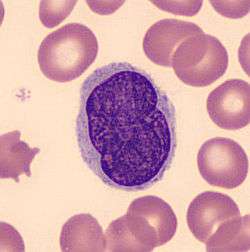Sézary disease
| Sézary disease | |
|---|---|
| Synonyms | Sézary's disease, Sézary('s) syndrome |
 | |
| The bright red rash of Sezary syndrome | |
| Pronunciation | /ˌseɪˌzɑːˈriː/ |
| Classification and external resources | |
| Specialty | oncology, dermatology |
| ICD-10 | C84.1 |
| ICD-9-CM | 202.2 |
| ICD-O | M9701/3 |
| DiseasesDB | 8595 |
| eMedicine | med/1541 derm/566 med/3486 |
| MeSH | D012751 |
Sézary disease is a type of cutaneous lymphoma that was first described by Albert Sézary.[1] The affected cells are T-cells (so it is a T-cell lymphoma) that have pathological quantities of mucopolysaccharides. Sézary disease is sometimes considered a late stage of mycosis fungoides with lymphadenopathy.[2][3] There are currently no known causes of Sézary disease.[4]
Signs and symptoms

Sézary syndrome and mycosis fungoides are T-cell lymphomas whose primary manifestation is in the skin.[5] The disease's origin is a peripheral CD4+ T-lymphocyte,[2] although rarer CD8+/CD4- cases have been observed.[2] Epidermotropism by neoplastic CD4+ lymphocytes with the formation of Pautrier's microabscesses is the hallmark sign of the disease.[2] The dominant symptoms of the disease are:
- Generalized erythroderma[2]
- Lymphadenopathy[2]
- Atypical T-cells ("Sézary cells") in the peripheral blood[2]
- Hepatosplenomegaly[6]
Diagnosis

Those who have Sézary disease often present with skin lesions that do not heal with normal medication.[7] A blood test generally reveals any change in the levels of lymphocytes in the blood, which is often associated with a cutaneous T-cell lymphoma.[7] Finally, a biopsy of a skin lesion can be performed to rule out any other causes.[7]
Treatment
Romidepsin, Vorinostat and a few others are a second-line drug for cutaneous T-cell lymphoma.[8] Mogamulizumab has been approved in Japan and waiting FDA approval in the United States. There are dozens of clinical trials, with a few in Phase III. Treatments are often used in combination with phototherapy and chemotherapy, though pure chemotherapy is rarely used today.[2] No single treatment type has revealed clear-cut benefits in comparison to others, treatment for all cases remains problematic.[9] Stanford University has been pioneering low-dose radiation (1/3 of the standard[10]), followed by stem-cell transplantation without chemo, as a potential cure with promising results.[11]
Some centers view the condition with an holistic approach,[12] testing for infections,[13] food sensitives and other conditions that may trigger disease progression, treating it first before moving to other medications.[14] "[A]ntibiotic treatment for S. aureus infection leads to decreased erythroderma and tumor size without other adjunct treatment."[15][16]
Epidemiology
Mycosis fungoides is the most common form of cutaneous T-cell lymphoma.[2] In the western population there are around 0.3 cases of Sezary syndrome per 100,000 people.[2] Sézary disease is more common in males with a ratio of 2:1,[2] and the mean age of diagnosis is between 55 and 60 years of age.[2][6]
See also
References
- ↑ Sézary's cell at Who Named It?
- 1 2 3 4 5 6 7 8 9 10 11 12 Cuneo A, Castoldi. "Mycosis fungoidses/Sezary's syndrome". Retrieved 2008-02-15.
- ↑ Thangavelu M, Finn WG, Yelavarthi KK, Roenigk Jr HH, Samuelson E, Peterson L, Kuzel TM, Rosen ST (May 1997). "Recurring Structural Chromosome Abnormalities in Peripheral Blood Lymphocytes of Patients With Mycosis Fungoides/Sézary Syndrome". Blood. 89 (9): 3371–7. PMID 9129044.
- ↑ "Causes and Symptoms". Retrieved 2008-02-15.
- ↑ Cerroni, Lorenzo; Kevin Gatter; Helmut Kerl (2005). An illustrated guide to Skin Lymphomas. Malden, Massachusetts: Blackwell Publishing. p. 39. ISBN 978-1-4051-1376-2.
- 1 2 Lorincz, A. I. "Sezary syndrome". Retrieved 2008-02-15.
- 1 2 3 "Diagnosis". Retrieved 2008-02-15.
- ↑ Jawed, SI; Myskowski, PL; Horwitz, S; Moskowitz, A; Querfeld, C (February 2014). "Primary cutaneous T-cell lymphoma (mycosis fungoides and Sézary syndrome): part II. Prognosis, management, and future directions.". Journal of the American Academy of Dermatology. 70 (2): 223.e1–17; quiz 240–2. doi:10.1016/j.jaad.2013.08.033. PMID 24438970.
- ↑ Cerroni, Lorenzo; Kevin Gatter; Helmut Kerl (2005). An illustrated guide to Skin Lymphomas. Malden, Massachusetts: Blackwell Publishing. p. 41. ISBN 978-1-4051-1376-2.
- ↑ 2016 Chicago 2-Day: Research Update https://www.youtube.com/watch?v=3GB6LV7GrsI
- ↑ Williams SC. "The rarest of rashes". Stanford Medicine.
- ↑ 2016 Los Angeles PEF - Integrative Medicine and Cutaneous Lymphoma https://www.youtube.com/watch?v=koi4ZRSDrtQ
- ↑ Novel Therapies for CTCL - Andrei Shustov, MD https://www.youtube.com/watch?v=OTYvjH_YuY8
- ↑ Skin bacteria may fuel cancer cell progression - March 02, 2016 - By Lisette Hilton http://dermatologytimes.modernmedicine.com/dermatology-times/news/skin-bacteria-may-fuel-cancer-cell-progression
- ↑ INFECTIOUS COMPLICATIONS OF CUTANEOUS T-CELL LYMPHOMA, March/April 2001 https://moffitt.org/File%20Library/Main%20Nav/Research%20and%20Clinical%20Trials/Cancer%20Control%20Journal/v8n2/185.pdf
- ↑ Association of Erythrodermic Cutaneous T-Cell Lymphoma, Superantigen-Positive Staphylococcus aureus, and Oligoclonal T-Cell Receptor Vβ Gene Expansion, Blood 1997, http://www.bloodjournal.org/content/89/1/32?sso-checked=true
External links
- Illustration of Sezary cells
- Biography of Sezary (in French)
- Sezary Syndrome lymphoma information
- Doctor's doctor
- Cutaneous Lymphoma Foundation
- Clinical trial number NCT00106431 for "A Single Agent Phase II Study of Romidepsin (Depsipeptide, FK228) in the Treatment of Cutaneous T-cell Lymphoma (CTCL)" at ClinicalTrials.gov
- Skin Research Center lab Hopital St Louis, Paris (France) Dir. Dr. A. Bensussan